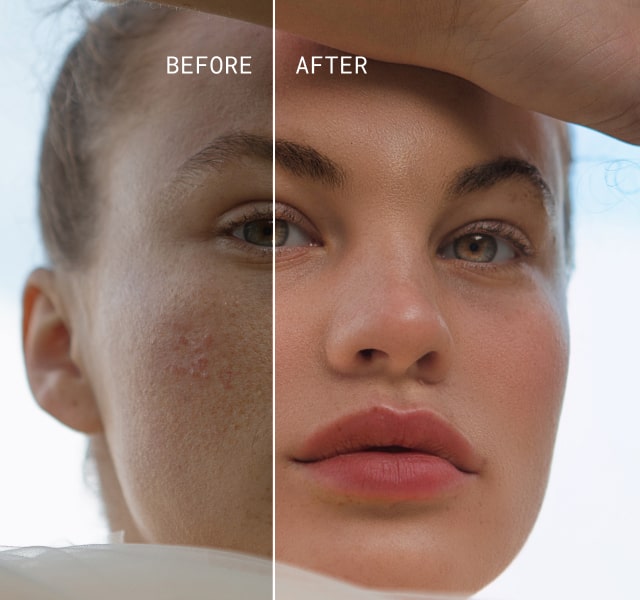Aperty vs Luminar Neo – Ein umfassender Vergleich für Fotografen
Januar 27, 2025
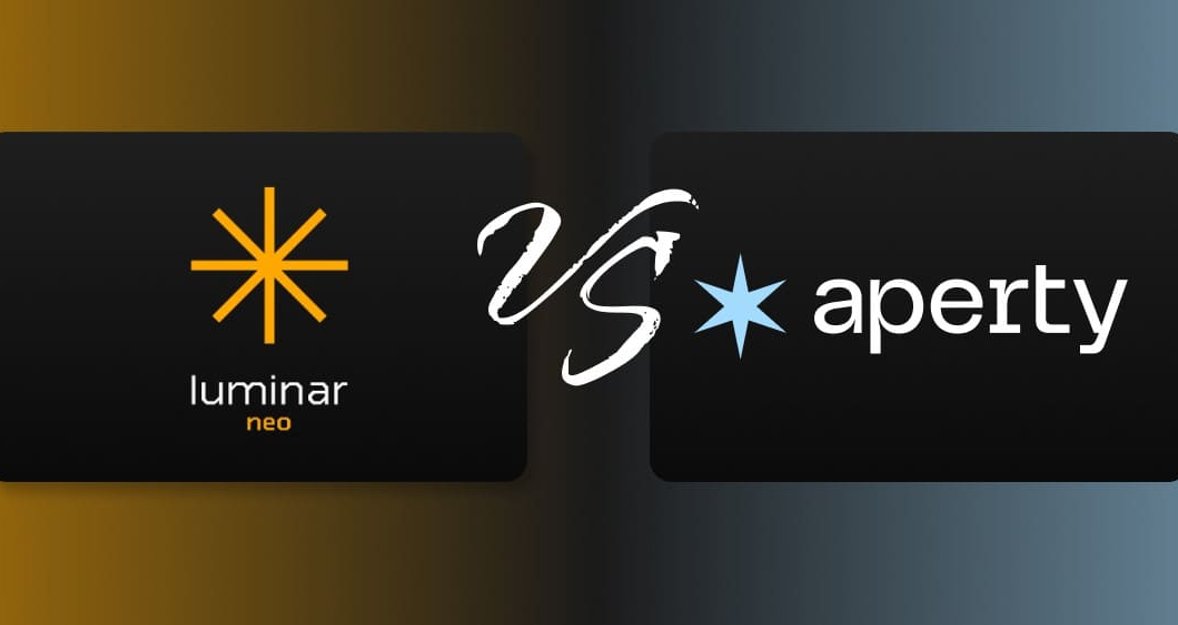
Entdecken Sie die wichtigsten Unterschiede zwischen Aperty und Luminar Neo in unserem detaillierten Vergleich. Perfekt für Fotografen, die ihre Bearbeitungsfähigkeiten verbessern möchten!
Skylums brandneue Porträtbearbeitungssoftware ist da: Aperty! Diese aufregende neue Software ist vollgepackt mit Funktionen, die den Arbeitsablauf für Fotografen optimieren und außergewöhnlich natürliche Ergebnisse liefern.
Aperty ist ein spezialisiertes Softwareprogramm, das speziell auf die Porträtfotografie ausgerichtet ist und Werkzeuge bietet, die sich auf detaillierte Retuschen und natürliche Verbesserungen konzentrieren. Wenn Sie derzeit Luminar Neo für die Porträtbearbeitung verwenden und überlegen, welches Programm für Sie besser geeignet ist, führt Sie dieser Artikel durch die wesentlichen Unterschiede, um Ihnen bei der Entscheidung zu helfen. Los geht's!
Überblick über Aperty und Luminar Neo

Zunächst werfen wir einen Blick auf beide Softwareprogramme und untersuchen, was sie Fotografen zu bieten haben.
Luminar Neo | Aperty |
Eine vielseitige Fotobearbeitungssoftware mit KI-gestützten Werkzeugen, geeignet für viele Fotografie-Genres. | Eine spezialisierte Fotobearbeitungssoftware, speziell für Porträtfotografen aller Porträtgenres entwickelt. |
Für Porträtfotografen bietet Luminar Neo KI-Werkzeuge wie Hautglättung, Makelentfernung und Optimierung von Gesichtszügen. | Verfügt über fortschrittliche 3D Face Mesh-Technologie für präzise und detaillierte Optimierungen der Gesichtszüge. |
Generative KI-Werkzeuge wie GenErase entfernen unerwünschte Elemente aus einem Foto und füllen den Raum nahtlos mit Texturen und Elementen, die zur Umgebung passen. | Bietet Batch-Retouching-Funktionen, mit denen Anpassungen auf mehrere Bilder angewendet werden können, um den Workflow zu beschleunigen. |
Enthält layerbasierte Bearbeitungsfunktionen, ideal für komplexere, mehrschichtige Projekte. | Entwickelt für schnelle Bearbeitungszeiten bei gleichzeitig hochwertigen, natürlich wirkenden Ergebnissen. |
Benutzerfreundliche Oberfläche, die Fotografen aller Erfahrungsstufen ein intuitives Bearbeitungserlebnis bietet. | Nutzt fortschrittliche Maskierungstechnologie, die spezifische Gesichtszüge, Körperteile und Tiefen in jedem Bild erkennt, um präzise Anpassungen zu ermöglichen. |
Da Luminar Neo eine breite Palette von Werkzeugen für Fotografen verschiedener Genres anbietet, ist Aperty speziell für die Porträtfotografie konzipiert. Tatsächlich ist es ein fortschrittlicher Hautretusche-Editor. Die leistungsstarken Retusche-Funktionen von Aperty und der Fokus auf Workflow-Effizienz machen es zu einer attraktiven Wahl für Porträtspezialisten.
In den folgenden Abschnitten werden wir die in jeder Software verfügbaren Tools im Detail untersuchen und ihre spezifischen Funktionen und Vorteile für Fotografen analysieren.
Weniger Zeit mit Bearbeiten, mehr Zeit zum Kreativsein Jetzt
Aperty ausprobierenBenutzeroberfläche und Workflow
Luminar Neo
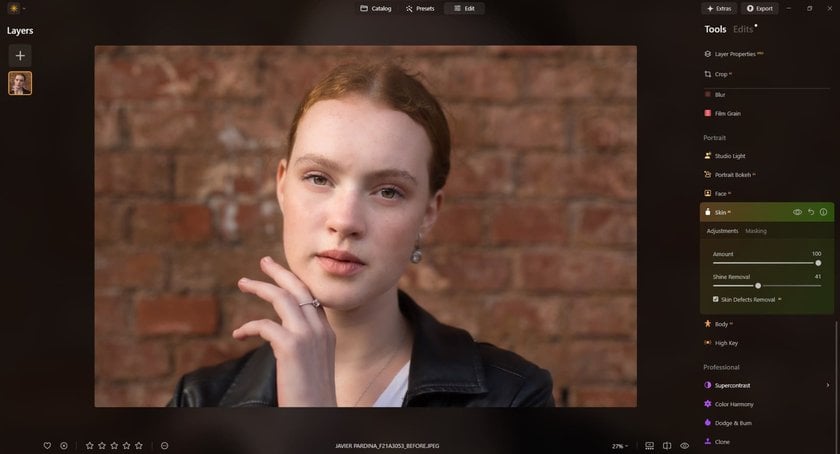 Luminar Neo bietet eine vielseitige Bearbeitungssuite, die Fotografen in verschiedenen Genres unterstützt. Von Anfängern bis hin zu Profis stellt Luminar Neo Werkzeuge für unterschiedliche Arten der Fotografie zur Verfügung, darunter landschaftsorientierte Tools wie den Landscape Enhancer sowie Porträtspezifische Retuscheoptionen.
Luminar Neo bietet eine vielseitige Bearbeitungssuite, die Fotografen in verschiedenen Genres unterstützt. Von Anfängern bis hin zu Profis stellt Luminar Neo Werkzeuge für unterschiedliche Arten der Fotografie zur Verfügung, darunter landschaftsorientierte Tools wie den Landscape Enhancer sowie Porträtspezifische Retuscheoptionen.
Ein wesentlicher Vorteil von Luminar Neo ist seine Vielzahl an KI-Werkzeugen, die Funktionen wie die Generierung von Inhalten, den Austausch von Himmeln und mehr ermöglichen – Funktionen, die Porträtfotografen möglicherweise nicht immer benötigen, die jedoch kreative Flexibilität für Fotografen bieten, die in mehreren Genres tätig sind.
Aperty
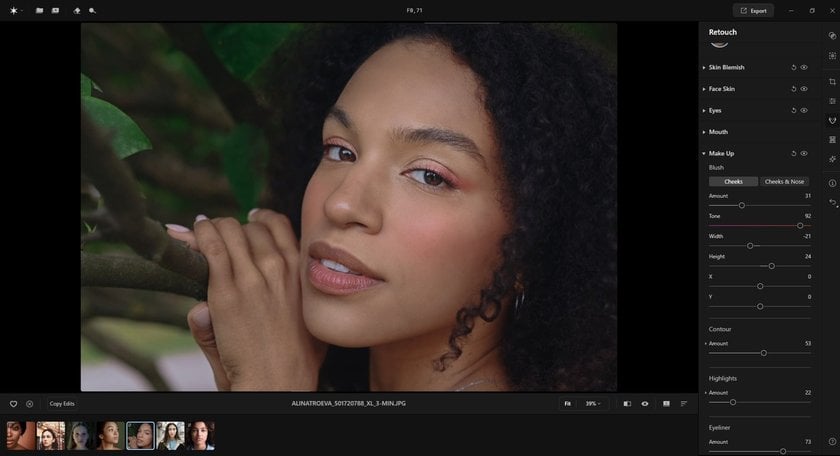 Die Benutzeroberfläche von Aperty wurde mit einem Hauptziel entwickelt: Geschwindigkeit. Porträtfotografen wissen, dass Retusche oft einen großen Teil ihres Workflows einnimmt, da sie detaillierte Anpassungen und präzise Bearbeitungen erfordert. Aperty wurde so gestaltet, dass diese Prozesse optimiert werden, sodass Fotografen mehr Zeit für Aufnahmen und weniger Zeit vor dem Bildschirm verbringen können.
Die Benutzeroberfläche von Aperty wurde mit einem Hauptziel entwickelt: Geschwindigkeit. Porträtfotografen wissen, dass Retusche oft einen großen Teil ihres Workflows einnimmt, da sie detaillierte Anpassungen und präzise Bearbeitungen erfordert. Aperty wurde so gestaltet, dass diese Prozesse optimiert werden, sodass Fotografen mehr Zeit für Aufnahmen und weniger Zeit vor dem Bildschirm verbringen können.
Vor Beginn der Bearbeitung in Aperty müssen Sie ein Projekt erstellen. Dies hilft nicht nur bei der Organisation, sondern optimiert auch den Workflow. Sobald ein Projekt eingerichtet ist, erscheint am unteren Bildschirmrand ein Filmstreifen, der alle Fotos dieses Projekts anzeigt. Mit dieser Funktion können Sie Einstellungen mühelos auf mehrere Bilder anwenden. Nach der Bearbeitung eines Fotos können Sie diese Anpassungen schnell auf ausgewählte Bilder oder das gesamte Projekt übertragen – alles innerhalb eines einzigen Fensters. Dieses Setup eliminiert die Notwendigkeit, zwischen verschiedenen Bildschirmen zu navigieren oder mehrere Tabs zu verwalten, was die Fertigstellung von Projekten erheblich beschleunigt.
Kernbearbeitungsfunktionen
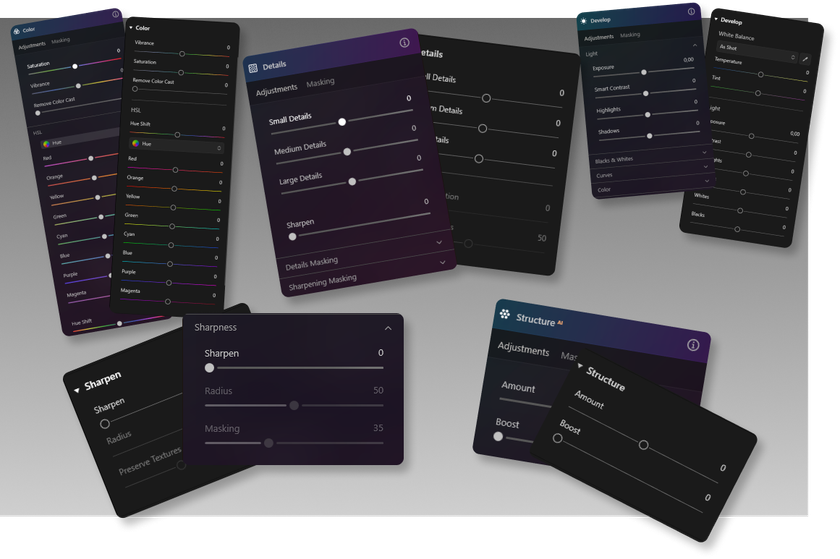
- Grundlegende Fotobearbeitung: Sowohl Aperty als auch Luminar Neo bieten wesentliche Bearbeitungsfunktionen wie Weißabgleich, Belichtung, Farbtemperatur und Tonkurvenanpassungen. Diese Anpassungen sind entscheidend, um das Gesamtbild eines Porträts zu verfeinern und ein ausgewogenes Ergebnis zu erzielen, bevor detailliertere Bearbeitungen vorgenommen werden.
- Farbkorrektur: Farbkorrektur ist eine weitere zentrale Funktion, die in beiden Programmen verfügbar ist. Aperty und Luminar Neo bieten ein Farbanpassungswerkzeug mit Einstellungen für Farbton, Sättigung und Luminanz, wodurch Fotografen Farben entweder realistisch oder stilisiert feinabstimmen können. Luminar Neo bietet jedoch zusätzliche Farbkontrollen, wie etwa die Colour Harmony, die präzise Farbbalance-Optionen bietet, und Toning, das Split-Toning-Anpassungen für Schatten und Lichter ermöglicht. Diese zusätzlichen Tools in Luminar Neo bieten Fotografen mehr Flexibilität, um komplexe Farblooks zu erstellen.
- Details: Zur Verbesserung der Bildklarheit bieten sowohl Aperty als auch Luminar Neo Werkzeuge wie Details, Schärfen und Structure, um Texturen und Kanten im Bild zu definieren. Darüber hinaus beinhalten beide Programme Rauschreduzierungsoptionen, um Körnigkeit zu minimieren – besonders nützlich bei Porträts mit wenig Licht oder hoher ISO. Luminar Neo hebt sich durch sein Noiseless-Tool hervor, eine leistungsstarke Funktion zur Rauschreduzierung, die sich ideal für stark rauschende Bilder eignet.
Sowohl Aperty als auch Luminar Neo decken die wichtigsten Bearbeitungsanforderungen ab, wobei Luminar Neo mit seinen zusätzlichen Werkzeugen zur Farb- und Rauschunterdrückung eine umfassende Option für ein breiteres Spektrum von Fotografen darstellt, während Aperty mit seinen optimierten Funktionen direkt auf porträtspezifische Bearbeitungsabläufe zugeschnitten ist.
Spezialisierte Porträtbearbeitungswerkzeuge
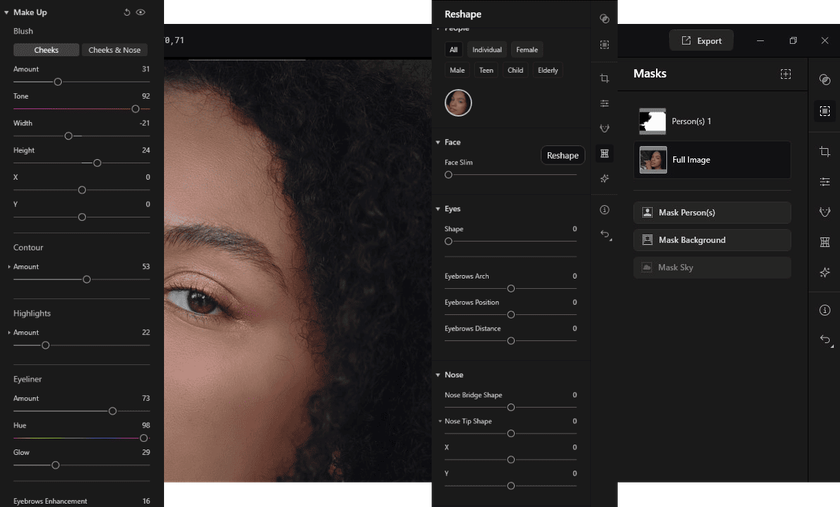
Die spezialisierten Porträtwerkzeuge von Aperty bieten Porträtfotografen ein höheres Maß an Detailgenauigkeit und Kontrolle, insbesondere für diejenigen, die nach verfeinerten und realistischen Retuscheoptionen suchen. Für Fotografen, die regelmäßig mit Porträtretusche arbeiten, könnten die fortschrittlichen Funktionen von Aperty von unschätzbarem Wert sein.
Luminar Neo | Aperty | |
Maskierungstechnologie | Grundlegende Menschensegmentierung | Fortgeschrittene Menschensegmentierung |
Gesichtserkennung | Bis zu 32 Gesichtspunkte | Bis zu 4000 Gesichtspunkte |
Umformungstool | Begrenzte Möglichkeiten | Erweitert |
Tiefenkartenschätzung | Standard | Hochpräzise |
3D Face Mesh | Nicht verfügbar | Verfügbar |
Makeup tool | Nicht verfügbar | Verfügbar: Rouge, Highlights, Konturen |
Wenn es um porträtspezifische Werkzeuge geht, bieten sowohl Aperty als auch Luminar Neo einzigartige Funktionen, um die Porträtfotografie zu verbessern. Fotografen, die mit Luminar Neo vertraut sind, können durch das Verständnis, was Aperty zusätzlich bietet, besser entscheiden, welche Software am besten zu ihrer Porträtarbeit passt.
- Maskierungstechnologie: Sowohl Aperty als auch Luminar Neo beinhalten KI-gestützte Maskierungstechnologien, die Gesichter und Körper erkennen und gezielte Anpassungen wie das Aufhellen des Gesichts ermöglichen. Luminar Neo bietet grundlegende Segmentierung, die Standardgesichtszüge und Körperteile erkennt. Aperty hingegen nutzt fortschrittliche KI-Technologie, die bis zu 30 Klassen von Gesichtszügen und Körperteilen identifizieren kann, was nuanciertere und präzisere Anpassungen ermöglicht. Mit Aperty sind detaillierte Korrekturen einfacher durchzuführen, was Fotografen die Kontrolle über selbst kleinste Details gibt.
- Gesichtserkennung und Umformung: Gesichtserkennungstools ermöglichen es beiden Programmen, spezifische Gesichtszüge zu erkennen, um Verbesserungen wie das Aufhellen der Augen oder die Sättigung der Lippen vorzunehmen. Luminar Neo erkennt bis zu 32 Gesichtspunkte, was eine effektive Retusche ermöglicht. Aperty hingegen nutzt die 3D Face Mesh-Technologie, die bis zu 4000 Gesichtspunkte erfasst. Diese zusätzliche Präzision bedeutet, dass Aperty komplexe Gesichtsbearbeitungen wie detaillierte Make-up-Anwendungen, Rouge und Konturen sowie erweiterte Umformungsmöglichkeiten unterstützt. Das Ergebnis sind äußerst präzise, natürlich wirkende Verbesserungen, die Aperty für eine fein abgestimmte Porträtbearbeitung hervorheben.
- Make-up: Ein herausragendes Merkmal von Aperty, das in Luminar Neo fehlt, ist die Möglichkeit, Make-up-Effekte in der Nachbearbeitung anzuwenden. Aperty erlaubt es, Make-up-Looks zu verbessern oder zu erstellen, einschließlich Rouge, Konturen, Highlights, Eyeliner und Lippenfarbenanpassungen. Dank der 3D Face Mesh-Technologie verschmelzen diese Effekte nahtlos mit der natürlichen Gesichtskontur des Models und liefern professionelle und realistische Ergebnisse.
Die speziellen Porträtwerkzeuge von Aperty bieten ein höheres Maß an Details und Kontrolle für Porträtfotografen, insbesondere für diejenigen, die raffinierte und realistische Retuschieroptionen suchen. Für Fotografen, die häufig mit Porträtretuschen arbeiten, können sich die erweiterten Funktionen von Aperty als unschätzbar erweisen.
Weniger Zeit mit Bearbeiten, mehr Zeit zum Kreativsein Jetzt
Aperty ausprobierenFazit
Wenn Sie ein Fotograf sind, der in verschiedenen Genres arbeitet, ist Luminar Neo wahrscheinlich die bessere Wahl. Mit seiner umfangreichen Auswahl an kreativen und KI-gestützten Werkzeugen erfüllt es vielfältige Bearbeitungsanforderungen. Dank seiner Vielseitigkeit unterstützt Luminar Neo alles von Landschafts- bis Architekturfotografie und passt sich mühelos unterschiedlichen Stilen und Anforderungen an.
Für Fotografen, die sich auf Porträtfotografie spezialisieren, ist Aperty jedoch eine wertvolle Ergänzung zu Ihrem Werkzeugkasten. Speziell für die Porträtfotografie entwickelt, wurde Aperty darauf ausgelegt, die Retusche zu optimieren und natürliche Ergebnisse mit Leichtigkeit zu liefern. Durch die Verkürzung der Bearbeitungszeit vor dem Bildschirm gibt Ihnen Aperty die Möglichkeit, sich wieder auf das zu konzentrieren, was Sie am meisten lieben: fantastische Porträtfotos aufzunehmen.
